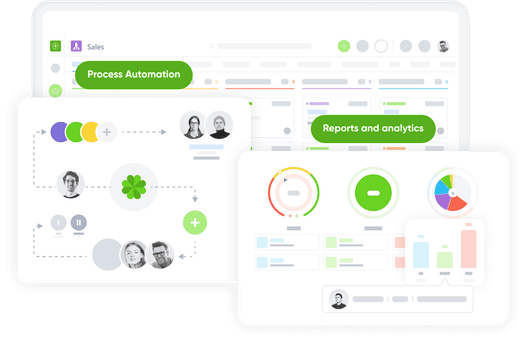Mastering Marketing Strategy for 2024: Template and Real-World Examples
Marketing often falls victim to stereotypes of extravagant budgets, loose timelines, haphazard strategies, high-profile influencers, and Snapchat filters

However, in reality, modern marketing plans are more intricate and meticulously orchestrated than a championship-winning football team's playbook.
Businesses, regardless of their size, face the challenge of ambitious goals and narrow profit margins. They require marketing plans that are both pragmatic and imaginative to achieve success. While larger corporations can afford to spend liberally on hiring celebrities like Taylor Swift for commercials and splurging on Facebook advertising, small businesses and startups must approach every expenditure with strategic precision.
If your business aims to make the most of every dollar, you've come to the right place. This article will guide you through creating a 2023 marketing plan that is effective even on a limited budget. We provide step-by-step instructions, outlines, illustrative examples, and more to equip you with the tools needed to bring your ideas to the market with precision.
What Is a Marketing Plan?
A marketing plan is a meticulously documented roadmap outlining how you intend to achieve marketing objectives such as boosting awareness, driving sales, increasing sign-ups, or enhancing event attendance. It details key performance indicators (KPIs), budgets, timelines, and covers everything from major milestones to granular
Marketing plans come in diverse forms and sizes. You might create a comprehensive marketing plan to chart your entire department's annual goals and strategies for the upcoming year. Alternatively, you could draft a marketing plan that delves into the launch strategy for a brand-new product set to debut next quarter. Much like Russian nesting dolls, substantial plans can encompass smaller ones.
These plans can be lengthy, concise, extensive, or succinct, depending on their intended purpose. If you're pitching your concept to venture capitalists or a local bank, you may require a substantial document replete with spreadsheets and financial projections. Conversely, when communicating the plan to your marketing team leads, a direct approach featuring tactics, deadlines, and deliverables may be more appropriate.
Irrespective of your particular needs, the following section will furnish you with the foundational elements necessary for constructing an effective marketing plan.
Creating an Effective Marketing Plan in 7 Key Steps
Developing a marketing plan is a dynamic process that involves seven essential steps. It's important to note that marketing plans are flexible documents that may require revisions along the way. Here's an overview of the seven-step process:
1. Define Your Marketing Goal
Begin by precisely defining your marketing objective. What are you aiming to accomplish? Is it increased sales, customer retention, or heightened brand awareness? Be specific about the desired outcomes and establish key performance indicators (KPIs) early on. These metrics will be crucial for measuring the success of your marketing efforts.
For instance, if your goal is to drive a specific number of website visitors, this figure will directly impact your budget, timelines, and chosen tactics. Additionally, if you're targeting a particular demographic, tailor your messaging and channels accordingly.
Refine your marketing goal into a succinct statement that can be easily communicated, such as: “Our objective is to attract 25,000 key decision-makers to our new product page by the end of October, while adhering to a limited marketing budget of $75,000.”
2. Identify Your Target Audience and Analyze Competitors
Describe the audience you intend to reach with your campaign. If you've already developed buyer personas, assign the persona that aligns with this specific campaign. However, if you're new to defining your target audience, invest time in understanding the individuals you're marketing to.
Depending on your product, industry, and market, consider demographics such as job titles, age, gender, marital status, location, income, and employer. To gain deeper insights, delve into psychographics, including hobbies, interests, influencers, shopping behaviors, values, and beliefs. Demographics provide the “who,” while psychographics unveil the “why.”
Imagine marketing a baseball glove; your approach will differ significantly based on the buyer's profile, whether they are a college athlete, a recreational player, a parent, or part of a low-income family. Understanding your audience's profile informs your messaging and channel selection.
Avoid overlooking this crucial step. Without a defined target audience, your marketing efforts may resemble throwing darts blindfolded, relying on luck rather than strategy. A well-defined audience, on the other hand, transforms success into a predictable science.
After identifying your audience, analyze your competitors. This research helps you understand who you're competing with for attention, SEO rankings, and influence. It can also reveal opportunities to fill gaps in your offerings that competitors may have overlooked.
Review comment sections and customer reviews of similar companies in your industry. Look for common complaints about product design, recurring issues with customer service, ineffective advertising or branding language, or unmet customer needs. By pinpointing your competitors' weaknesses or unaddressed customer pain points, you gain valuable insights to differentiate your business effectively.
3. Allocate Your Marketing Budget
A crucial aspect of your marketing plan is setting budget constraints. Without defined limits, plans could entertain extravagant ideas like a
However, the real magic of marketing plans lies in transforming modest budgets into impressive returns on investment (ROI). The key is to prioritize the most effective channels, messaging, and tactics that make every dollar count.
Determine in advance the budget required to achieve the goals established in Step 1. While there may be instances where you need to inject additional funds into the campaign later, strive to create a marketing plan that operates effectively within your budget constraints.
Remember, success is not defined by a limitless budget but by astute decision-making that maximizes ROI. For cost-effective yet creative strategies, explore our Small Business Marketing Guide: From Scratch to Success.
4. Establish Your Deadlines
Deadlines are the guardrails that define the boundaries of your marketing campaign. A plan without deadlines is akin to a never-ending journey towards your objective, and granting yourself an unlimited timeframe to achieve a sales goal is seldom advisable.
Set realistic yet ambitious deadlines. The sooner you accomplish your goal, the quicker you can advance to the next, ensuring each milestone propels your business forward.
Determine the final deadline for achieving your primary KPI. Then, delineate the essential milestones that mark the path to success. These milestones might pertain to launching various components of your campaign, such as hosting four webinars, publishing ten supporting blog posts, or securing mentions in two prominent news outlets.
Lastly, pinpoint the start date for initiating your marketing activities. Avoid assuming it's an immediate launch; you might have a few weeks to prepare and organize before diving into the marketing campaign's hectic landscape.
5. Select Your Marketing Channels and Strategies
Choosing the right marketing channels and tactics is undoubtedly one of the most exciting aspects of crafting a marketing plan. This step empowers you to decide on the channels, strategies, and deliverables that align with your goals. The choice of channels and tactics should be influenced by your target audience, product or service, and industry. Here are some popular options to consider:
Email Marketing: A tried-and-true digital marketing tactic, email marketing boasts an average ROI of $40 for every $1 invested, making it highly cost-effective. It's a channel where you can learn to excel through our comprehensive email masterclass.
Social Media Marketing: Utilize platforms like Instagram, Facebook, Snapchat, YouTube, or TikTok for organic strategies or targeted paid campaigns. Social media marketing allows you to connect with consumers in their preferred digital spaces.
PPC Marketing: Pay-per-click (PPC) marketing enables you to run advertising campaigns on search engine pages and various websites across the internet. It's a competitive method for getting your content in front of the right audience.
Content Marketing: Combine content marketing with a robust search engine optimization (SEO) strategy for long-term success. This tactic can generate organic traffic to your website over an extended period.
The common thread among these channels is their ability to provide precise monitoring of results, allowing you to track progress and determine whether a particular channel justifies your investment. Unlike traditional outbound advertising with vague impressions and influence, digital marketing strategies offer transparent insights into your return on investment.
6. Develop a Detailed To-Do List and Assign Responsibilities
In this phase, you delve into the granular aspects of your marketing plan. Step 6 involves outlining all the tasks that must be executed, such as:
Conducting a launch meeting.
Scheduling recurring meetings and synchronization points.
Crafting messaging.
Creating creative assets.
Identifying promotional channels.
Planning post-mortem evaluations.
This list is just a starting point; ensure that you encompass every element required to transform your plan into reality. Once you've itemized the necessary tasks, it's time to assign responsibilities. Each deliverable must have an accountable team member.
At this juncture, you may encounter roadblocks. You might discover that your creative team is overwhelmed and cannot accommodate creative requests immediately, or you may realize that other ongoing email campaigns or social media advertisements demand top priority.
In such cases, return to Step 4 and revisit your timeline. Make necessary adjustments to ensure there's adequate bandwidth available to execute your marketing plan effectively. Flexibility in your plan allows for smoother implementation while accommodating unforeseen challenges.
7. Monitor Performance and Analyze Data
A crucial element of any marketing plan is continuous monitoring and data analysis. Recognize that no marketing plan unfolds without challenges, and it's essential to stay attuned to what's working and what needs adjustment. Fortunately, most digital tactics provide the flexibility to make real-time changes.
Become well-acquainted with fundamental marketing analytics tools to effectively gauge your plan's effectiveness. Here are some essential tools to consider:
Facebook Ads Manager: Ideal for assessing the performance of your Facebook advertising campaigns. It provides insights into ad reach, engagement, conversion rates, and more.
Google Analytics: A powerful tool for tracking website traffic, user behavior, and conversions. It helps you understand how users interact with your site and which marketing efforts are driving results.
Google Search Console: Useful for monitoring your website's performance in Google search results. It provides valuable data on search queries, click-through rates, and site visibility.
Semrush or Ahrefs (for SEO): These tools are invaluable for SEO analysis. They offer insights into keyword rankings, backlinks, competitor research, and site audit reports.
Regularly reviewing and interpreting data from these tools allows you to make informed decisions, refine your strategies, and optimize your marketing plan for better results.
Marketing Plan Template: [Name of Project]
Marketing Goal
Our marketing goal for the [Name of Project] is to [insert specific marketing goal here]. We aim to achieve [insert KPIs, e.g., increased sales, website traffic, brand awareness] by [insert deadline]. This goal aligns with our overall company objectives of [mention how it ties back to company goals].
Target Audience
Our target audience for this campaign is [describe the audience persona(s) in detail]. They are [mention characteristics, demographics, and behaviors] and are likely to be interested in our [product/service]. Understanding their needs and preferences is crucial for tailoring our marketing efforts effectively.
Marketing Budget
For this campaign, we have allocated a budget of [mention the budget amount]. This budget will cover expenses related to [list budget allocations, e.g., advertising, content creation, design, etc.]. We will closely monitor our spending to ensure optimal resource utilization.
Timeline
Our campaign timeline is as follows:
Launch Date: [Insert Launch Date]
Preparation Period: [List important milestones leading to the launch]
Campaign Duration: [Specify the campaign duration]
Having a clear timeline ensures that we stay on track and meet critical deadlines throughout the campaign.
Marketing Tactics
To achieve our marketing goal, we will employ the following tactics and channels:
[List the marketing tactics and channels you plan to use, e.g., social media marketing, email marketing, content creation, SEO, paid advertising, etc.]. Provide a brief description of each tactic and how it contributes to the campaign's success.
Clearly defined roles and responsibilities will help ensure that each team member understands their tasks and can contribute effectively to the campaign's execution.
Marketing Plan Example (Filled Out)
Marketing Plan Template: [Project Zeus Running Collection]
Marketing Goal
Drive $200,000 in sales for the new Zeus running collection within the first 4 months of launch day. This goal aligns with our company's objective of expanding our product offerings and increasing revenue.
Target Audience
The primary audience is 35 to 50-year-old male recreational runners who tend to run
Marketing Budget
We have a budget of $40,000 for the initial launch period. If we can prove out the Zeus Running Collection, we’ll allocate additional budget after the first 4 months.
Timeline
Launch Day: June 1
Marketing Assets Ready to Go: May 28
Pre-Launch Teaser: May 24
Creative Assets Finished: May 21
Product Beta Tester Reviews Submitted: May 10
Written Content Creation Period: April 12 – May 7
Enlist Beta Testers: April 12
Project Kickoff Meeting: April 5
Marketing Tactics
Social Media Marketing: Target runners on Instagram and Facebook with paid ads featuring our endorsed runner racing in the shoe.
Email Marketing: Email existing customers with a 15% off discount code on the new Zeus Running Collection. Email prospects with a link to the product breakdown page with a code for free shipping.
Responsibilities and Assignments
Lizzy K: Creative assets
Mark B: Blog post announcement + product page
Spencer S: Beta tester outreach
Larry G: Email and social media marketing campaigns
Carly M: Project manager
This structured marketing plan provides a clear roadmap for our campaign, ensuring that everyone knows their roles and responsibilities, and that we work efficiently towards achieving our goals.
Marketing Plan FAQs
1. Do I need to write a marketing plan for everything?
Not every marketing initiative requires a full-fledged marketing plan. Marketing plans can vary in scope, and their necessity depends on the specific goals and complexity of the project. While flexibility is important, having a well-documented plan can provide a solid foundation for your team. A good marketing plan serves as a strategic roadmap, particularly for initiatives with significant goals or challenges. It allows for adjustments while maintaining alignment with overarching objectives.
2. How do I know if my marketing plan is a success?
Measuring the success of your marketing plan is crucial. Use the SMART goal method (Specific, Measurable, Achievable, Relevant, Time-bound) to ensure your plan's objectives are clear and actionable. Success in marketing is not solely determined by meeting the set goals; it also involves learning and adapting throughout the process. Every marketing plan should yield valuable insights about your customers, tactics, and business. Whether you achieve your goals or not, consider the learning process a success, as it contributes to your overall marketing knowledge and strategy refinement.
3. Who should make a marketing plan?
Ideally, anyone responsible for marketing within your organization should be involved in crafting a marketing plan. Typically, marketing managers or team members take the lead in drafting these plans. However, it's crucial for marketing strategy to originate at an enterprise level. Encourage cross-functional collaboration and alignment, as a well-understood marketing plan can lead to better synergy across different departments. In larger organizations, it's not uncommon for the marketing team to work closely with product and sales teams to ensure everyone is on the same page and working towards common goals.
Plan It Out—Make It Happen
Every successful marketing campaign begins with a well-thought-out plan. Don't leave the success of your startup to chance; invest time and effort into creating a strategic marketing plan. With the right plan in place, you can approach your business initiatives with confidence, knowing that you're following a well-defined roadmap.

Matteo Bianchi
Share





